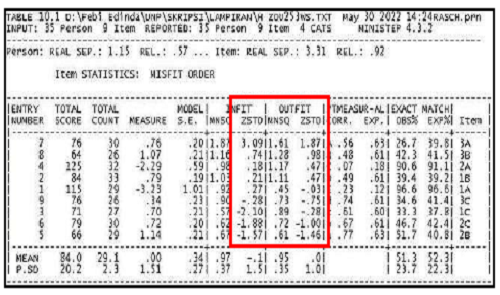
Development of Test Instruments to Test Students' Understanding of Macroscopic, Sub-Microscopic and Symbolic Levels in Acid-Base Titration Material Using the Rasch Model
Abstract
This study created a test instrument that can test students' understanding of the macroscopic, sub-microscopic and symbolic levels in acid-base titration material that has been tested for validity, reliability, difficulty index and differential power of the questions . This development research uses the Rasch model. The subjects of this study were four lecturers, two high school chemistry teachers and 35 students of SMA N 2 Padang. The object is the quality of the test instrument that meets the criteria of validity, reliability, difficulty index and discriminatory power . Data analysis used the MiniFac and Ministep programs. This study has 10 stages, namely: (1) Defining the construct, (2) Identifying the construct, (3) Designing the items, (4) Testing the product, (5) Analyzing the data, (6) Reviewing the results of the analysis, (7) Reviewing the map wright, (8) Repeat steps 4-7, (9) Claim product quality, (10) Develop documentation. The results showed that the suitability of validation by experts using the MiniFac program was the exact agreement and expected agreement values were very close, namely 95.8% and 95.4%, this indicated that the results of this analysis fit the model and its estimation. Likewise testing of students using the Ministep program. Each item can be said to be valid because it meets the criteria of the MNSQ, ZSTD and PtMean Corr. The instrument is also claimed to be reliable because it has a value of 0.92 . The difficulty index and discriminating power of the items also varied from the easiest to the most difficult.
Keywords
Full Text:
PDFReferences
Ashraf, Z. A., & Jaseem, K. (2020). Classical and Modern Methods in Item Analysis of Test Tools. International Journal of Research and Review, 7(7), 397–403.
Azwar, S. (2012). Reliabilitas dan Validitas. Pustaka Belajar.
Bagiyono. (2017). Analisis Tingkat Kesukaran dan Daya Pembeda Butir Soal Ujian Pelatihan Radiografi Tingkat 1 The Analysis of Difficulty Level and Discrimination Power of Test Items of Radiography Level 1 Examination. Widyanuklida, 16(1), 1–12.
Boone, W. J., & Noltemeyer, A. (2017). Rasch analysis: A primer for school psychology researchers and practitioners. Cogent Education, 4(1), 1–13.
Daryanto. (2010). Evaluasi Pendidikan. Rineka Cipta.
Desnita, Yusmaita, E., Iswendi, & Iryani. (2021). Studi Tingkat Preferensi Panelis Terhadap Karakteristik Sensori Selai Kolang Kaling (Arenga Pinnata Fruits). Jurnal Ilmiah Pengabdian kepada Masyarakat, 5(2), 75–81.
Eliza, W., & Yusmaita, E. (2021). Pengembangan Butir Soal Literasi Kimia pada Materi Sistem Koloid Kelas XI MIPA SMA/MA. Jurnal Eksakta Pendidikan (JEP), 5(2), 197–204.
Friatma, A., Syamsurizal, S., & Helendra, H. (2017). Analyzed Quality Question of Final Exam Whole Semester on Biology Course Class XI IPA SMA Negeri District South of Solok Selatan Academic Year 2015/2016. Bioeducation Journal, 1(2), 50–67.
Gabel, D. . (1993). Handbook of Research on Science Teaching and Learning. Maccmillan Company.
Sumintono, B., & Widhiarso, W. (2015). Aplikasi Pemodelan Rasch: Pada Assessment Pendidikan. Trim Komunikata.
Wei, S., Liu, X., Wang, Z., & Wang, X. (2012). Using rasch measurement to develop a computer modeling-based instrument to assess students’ conceptual understanding of matter. Journal of Chemical Education, 89(3), 335–345. https://doi.org/10.1021/ed100852t
DOI: http://dx.doi.org/10.31258/jes.7.2.p.269-281
Refbacks
- There are currently no refbacks.
Copyright (c) 2023 Febi Edinda Putri

This work is licensed under a Creative Commons Attribution 4.0 International License.
Publisher: FKIP Universitas Riau












